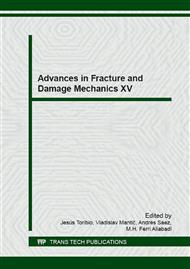p.38
p.42
p.46
p.50
p.54
p.58
p.62
p.66
p.70
Micromechanical Boundary Element Modelling of Transgranular and Intergranular Cohesive Cracking in Polycrystalline Materials
Abstract:
In this paper a cohesive formulation is proposed for modelling intergranular and transgranular damage and microcracking evolution in brittle polycrystalline materials. The model uses a multi region boundary element approach combined with a dual boundary element formulation. Polycrystalline microstructures are created through a Voronoi tessellation algorithm. Each crystal has an elastic orthotropic behaviour and specific material orientation. Transgranular surfaces are inserted as the simulation evolves and only in those grains that experience stress levels high enough for the nucleation of a new potential crack. Damage evolution along (inter-or trans-granular) interfaces is then modelled using cohesive traction separation laws and, upon failure, frictional contact analysis is introduced to model separation, stick or slip. Moreover some physical consideration based on cohesive energies were made, in order to guarantee the cohesive model in consideration was appropriate for the purpose of this work. Finally numerical simulations have been performed to demonstrate the validity of the proposed formulation in comparison with experimental observations and literature results.
Info:
Periodical:
Pages:
54-57
Citation:
Online since:
September 2016
Authors:
Price:
Сopyright:
© 2016 Trans Tech Publications Ltd. All Rights Reserved
Share:
Citation:


